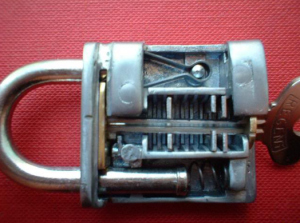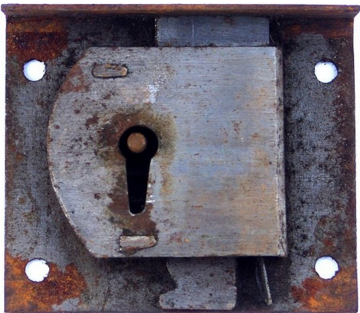A warded lock, which is also called a ward lock, is a kind of lock that makes use of a set of various obstructions, or wards, in order to prevent the lock from getting opened, unless the proper key gets inserted. The proper key contains slots of notches that correspond to the lock’s obstructions, enabling it to properly rotate in a free manner inside the lock.
A set of obstructions are used in the most common kinds of warded locks, which usually consist of concentric plates that face upwards. Even though the standard continues to remain the same, depending on the specific locks used, the warded lock may either possess a few complex wards that have protrusions within them or even a single, easy protrusion. In order for this lock to properly turn, the notches or slots must correctly correspond to the lock’s wards, otherwise the specific key will hit a certain impediment and prevent the lock from getting turned. Provided the right key is inserted, the clearing of the wards of the key will revolve in the center post. Thank you to the guys at tigardlocksmith.org for all the helpful information provided.
Brief History of Warded Locks
 The warded locks and their specific designs have been used for many years. Numerous different variations of this kind of lock are still with us today for a wide range of functional scenarios, which have maintained this lock type in demand thoughout the ages. One of the most ancient lock designs ever made and still in use today, the warded lock is a fixed projection that is intended to effectively block unauthorized keys from entering or operating the lock.
The warded locks and their specific designs have been used for many years. Numerous different variations of this kind of lock are still with us today for a wide range of functional scenarios, which have maintained this lock type in demand thoughout the ages. One of the most ancient lock designs ever made and still in use today, the warded lock is a fixed projection that is intended to effectively block unauthorized keys from entering or operating the lock.
Older editions of warded locks can be compared to the big metal casing kinds, complete with a huge keyhole that are mostly associated with the skeleton key, which may bring to mind those big old locks that are used in scary films, treasure chests and haunted houses. They are often called the ‘church door lock’, which is a substantial stock lock that usually contains two bolts. It has metals bands or different decorations in an ecclesiastical design. They date way back from the beginning of the nineteenth century through the early twentieth century. The church door locks are often of very large size and were popular fittings. As a matter of fact, many of these church door locks are still used and are in service today!
Warded Locks – The Decorative Lock
Warded locks are still used today for a wide range of different lower-security applications, such as closet doors, cabinet locks and padlocks. The specific key that is implemented for the warded locks possess slots that match the lock’s notches, which allow it to rate the unimpeded present in the lock. Due to this lock’s design, a well-made skeleton key may be constructed to bypass the lock’s wards. This is exactly the reason why warded lock mechanisms are usually used in applications of low security. There is additionally a very small sum of unique keys that can be effectively produced, so numerous keys will have the option to open other different doors that they weren’t made to open.
Warded locks are often called the ‘bitkey lock’ and may be identified by their square cut keys with their wide keyway that looks like a saw tooth, thus the skeleton key, which resembles the skull on the bigger, more aniquated editions of the warded locks. That is why there is often an association between the warded locks and decoration. This specific lock and key look very fancy, which explains why they are often used for applications that need to have a fancy appearance and that focus less on security.
Consider the Right Lock for you
If you are currently in need to buy locks for different circumstances and are trying to make a decision on the best locks for your specific situation, then it is important to perform as much research as possible and talk with a local locksmith to order to grasp the best and most updated information of the work for which you need the lock.
As previously stated, warded locks provide very little when it comes to security in comparison to other locks available on the market, however they certainly provide a decorative look and style that no other lock can provide. Therefore, make sure to take your time and consider your specific needs when deciding what lock you should purchase for your project.
